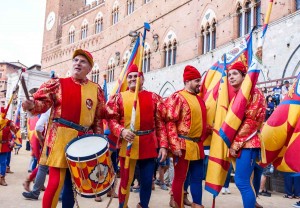
©Bigstock.com
A lot can happen in 100 seconds, but also very little. What sounds like an underhanded attack on masculinity is actually a description of the Palio di Siena, most likely Italy’s most famous horse race. Ten each of the 17 contrade or city wards compete in this spectacular contest on two dates – July 2nd and August 16th – attracting thousands of guests from all around the world. The Palio has also been the equally dramatic and action-packed setting for numerous movie blockbusters. But what is it about this highly traditional race with roots dating back to medieval times that makes it such a spectacle?
How it all started
The exact origins of the Palio are largely obscure today. Precursors and first attempts supposedly took place between the 11th and the 13th century depending on the interpretation of the available historic evidence. Piazza del Campo, Siena’s city square, saw all kinds of games and contests in the Middle Ages, such as jousting, combats and bullfights. Larger-scale races, the “palli alla lunga”, used to lead through the entire city. After Ferdinando I de’ Medici, Grand Duke of Tuscany, banned bullfighting in 1590, the contrade began to organise races on Piazza del Campo. Initially raced on bulls and, later, on donkeys, the city wards decided on horseback racing in 1633.
Two dates and limited participation
Originally, the Palio was only held on July 2nd in honour of the Madonna di Provenzano (which is why the race is also known as the “Palio di Provenzano”). That changed in 1701, when the first additional race on August 16th in honour of the Assumption of Mary (“Palio dell’Assunta”) took place. Initially hosted by the contrada victorious in July and thus frequently only contested every other year, the city of Siena took responsibility of organising and funding the August date turning it into an annual event. A few decades previously, in 1729, Siena’s then-governor Violante of Bavaria re-defined the formal boundaries of the city wards (contrade) and restricted the number of participants to ten per race.
How the race works
“Only” ten contrade per race have been allowed for nearly 300 years. The entry field features the seven contrade that had to sit out the respective date in the previous year and three other contrade drawn by lot. Therefore, some city wards can participate in both annual races. Winning in both July and August, however, is very rare. The so-called “cappotto” (Eng. “coat” or “grand slam”) has only been achieved 17 times, most recently in 2016 (Lupa), 1977 (Giraffe) and 1933 (Tartuca).
The riders and horses don’t belong to any of the contrade. While the capitano, the captain of each city ward’s team, rents and pays the jockey of choice, the horses are drawn by lot. The day of the race itself starts with a big, historical procession. Each of the participating contrade presents its coat of arms while wearing medieval costumes. After that, the magic happens on the approx. 300-m-long outer ring of the Piazza del Campo now sporting a special, 20-cm-thick surface made from sand and tuff. Things get tight and cramped on the only 7.5-m-wide lane when the starting positions are assumed. The race starts as soon as the starting rope (“canapo”) has been dropped with the jockeys riding their horses bareback three times around the square. Shoving, pulling and hampering one another is part of this action-packed, breathtaking race. The spectacle is over after only 100 seconds. The contrada whose horse crosses the finishing line first – with its diadem, but not necessarily with its rider – wins and receives the Palio, a silk ribbon. Almost immediately afterwards, the festivities start frequently lasting several weeks, before things become quiet again. Winter, as the Siennese like to say, starts on August 17th.
The Palio di Siena features not one, but two spectacular races with equally awesome festivities before and after the two dates in July and August. If you want to be there yourself, you should book your room as far in advance as possible, as the entire city is usually fully booked around the time of the races. Be there live and explore the surrounding region of Tuscany with the travel suggestions by ZAINOO!